Leadership & Workforce Management
Building a Career Ladder for Medical Imaging Technologists
July 23, 2025 - Jose E. Rodriguez, CRA
Editor’s Note: This article originally appeared in the May/June 2025 issue of Radiology Management and is being republished with permission.
Abstract
This article explores developing and implementing a career ladder for medical imaging technologists, emphasizing its role in fostering professional growth, enhancing workforce stability, and improving patient care. Medical imaging technologists are essential to healthcare yet often face limited opportunities for advancement. A structured career ladder provides clear pathways for specialization, leadership, and advanced practice roles, ensuring alignment with organizational goals and market demands. Key components include defined entry-level roles, specialization tracks, leadership pathways, and academic and professional development opportunities. The article highlights the importance of aligning career ladders with salary grading and regional market trends to ensure competitiveness and equity. This review discusses strategies for overcoming implementation challenges, such as funding constraints and resistance to change, as well as methods for monitoring success. By investing in career ladders, healthcare organizations can attract, retain, and develop top talent, advancing workforce excellence and delivering superior patient outcomes.
Introduction
Defining an organizational workforce sustainability plan has become increasingly crucial in today’s fast-paced and continuously growing industry. This strategic plan designed by an organization will ensure it has the necessary talent and workforce capabilities to thrive long-term by focusing on employee well-being, diversity, skills development, and retention practices, allowing the company to adapt to future challenges and maintain productivity over time.¹ Of course, this responsibility falls on each organization, and often each department, to establish its own defined growth path. Development of these plans can be cumbersome, overtly overcomplicated, and overwhelming for many inexperienced or experienced leaders; however, this does not diminish the necessity. A significant part of this workforce planning involves the development of a well-defined imaging technologist career ladder.
Medical imaging technologists play a critical role in healthcare by performing diagnostic and therapeutic imaging procedures that aid in diagnosing, treating, and monitoring medical conditions. Despite their essential contributions, many technologists face limited opportunities for professional growth, which can lead to job dissatisfaction and staff turnover. A well-designed career ladder addresses these challenges by providing clear pathways for advancement, specialization, and leadership, empowering technologists to enhance their skills while aligning their career progression with the evolving needs of the healthcare system.
Importance of a Career Ladder
A career ladder is crucial for fostering professional growth among medical imaging technologists, providing structured pathways for learning, specialization, and leadership. By establishing clear opportunities for advancement, career ladders encourage technologists to pursue continuing education, obtain advanced certifications, and refine their skills, keeping pace with evolving healthcare technologies and practices. This continuous professional development enhances the workforce’s expertise and instills a sense of purpose and motivation among employees, increasing job satisfaction and long-term career engagement.² Human resource (HR) best practices emphasize the role of career development opportunities in boosting employee morale and retaining skilled staff, as noted by the Society for Human Resource Management (SHRM), which highlights that employees are more likely to stay with organizations that invest in their growth.³
From an organizational perspective, implementing a career ladder improves retention and morale by demonstrating a commitment to employee development and recognizing their contributions. The ability to advance within their roles reduces turnover, which is particularly significant in the healthcare industry, where staff shortages can directly impact patient care.⁴ Moreover, a career ladder aligns with institutional goals for excellence by ensuring a highly skilled workforce capable of meeting complex patient care demands. SHRM and other HR resources advocate for career ladders to enhance organizational resilience, noting that clear advancement opportunities are linked to higher engagement levels and better performance outcomes.³
Career ladders also serve as a benchmark for aligning with industry standards and adopting best practices from other healthcare institutions. For example, organizations that successfully implement career ladder programs, such as the Mayo Clinic and Cleveland Clinic, report improved workforce stability and enhanced service quality.⁵ ⁶ By integrating these models, healthcare institutions can position themselves as employers of choice, attracting top talent and maintaining competitiveness in a demanding industry.⁷ The benefits of such programs underscore the importance of prioritizing career development as an essential component of strategic workforce planning.
Components of an Effective Career Ladder
Career Entry
As with many healthcare professions, entry in radiology is completed through appropriate educational programs, which serve as a foundation for individuals preparing to become certified or registered radiologic technologists. Student technologists typically begin their journey by enrolling in an accredited radiologic technology program, which integrates both didactic and clinical education. Didactic training focuses on the theoretical aspects of radiology, such as anatomy, physiology, patient care, radiation safety, imaging physics, and radiographic procedures. This phase often includes simulated lab experiences to build initial skills before transitioning to clinical rotations. During clinical training, student technologists gain hands-on experience in healthcare settings under supervision, performing routine imaging exams, patient positioning, and image quality assessments while adhering to safety standards. Progress is monitored through clinical competencies that students must demonstrate to advance.
Training is deemed complete when individuals meet all competency and educational milestones. These milestones include documenting clinical competencies outlined by accrediting bodies such as the JCERT, ABHES, or ARRT, graduating from an accredited program, or completing a training program aligned with state-specific guidelines.⁸ ⁹ Certification or registration, such as passing the ARRT Radiography Certification Exam, signifies that the individual has achieved the qualifications required to practice as an entry-level radiologic technologist.
The role of a designated preceptor is critical in developing student technologists. Preceptors are experienced radiologic technologists or instructors who mentor trainees, ensuring they acquire the necessary technical, clinical, and professional skills. These mentors are responsible for assessing trainee performance, providing feedback, and certifying competency sign-offs. Preceptors also play a key role in modeling best practices in patient care, equipment handling, and safety protocols, ensuring that trainees are fully prepared for independent practice.
Specialization Tracks
Medical imaging offers a variety of specialization tracks, allowing technologists to focus on specific modalities such as magnetic resonance imaging (MRI), computed tomography (CT), ultrasound, mammography, or interventional radiology. Specializing in a particular modality enhances technical expertise and opens opportunities for career advancement and higher earning potential. For instance, MRI technologists require a deep understanding of magnetic resonance physics and patient safety protocols, while interventional radiology specialists must master intricate procedures that involve guiding catheters and wires under fluoroscopic guidance. These roles demand precision, critical thinking, and a commitment to continuous learning, making specialization a rewarding path for those seeking to excel in the field.
Certifications and advanced training opportunities further support career growth for imaging technologists. Organizations like the American Registry of Radiologic Technologists (ARRT) and other accrediting bodies offer certifications that validate expertise in specific modalities. Advanced certifications, such as ARRT’s CT or MRI credentials, are often prerequisites for employment in specialized areas.⁹ ¹⁰ Moreover, professional development opportunities, such as workshops, conferences, and modality-specific training programs, enable technologists to stay current with the latest advancements.¹¹ Pursuing these certifications demonstrates dedication to the field and enhances employability and credibility among peers and employers.
Leadership and Advanced Practice Roles
Pathways to leadership roles, such as lead technologist, supervisor, or director, are critical components of a robust career ladder. These positions involve overseeing departmental operations, mentoring staff, and ensuring compliance with regulatory standards. Progressing into leadership roles often requires clinical experience, strong communication skills, and the ability to manage people and processes. Many organizations offer leadership training programs to prepare technologists for these roles, emphasizing skills in strategic planning, conflict resolution, and quality assurance. Certification agencies, such as the Radiology Administration Certification Commission, offer advanced certifications, such as the Certified Radiology Administrator (CRA), to validate the leadership knowledge and skills required to perform as an imaging leader.¹² Transitioning into leadership broadens professional horizons and allows technologists to play a pivotal role in shaping the future of their departments.
Advanced practice roles, such as Registered Radiologist Assistants (R.R.A.s), represent another significant opportunity for career growth. R.R.A.s work under the supervision of radiologists to perform advanced imaging procedures, assist with patient management, and improve workflow efficiency.⁹ This role requires additional education and certification, typically a master’s degree in radiologic science and passing the ARRT’s advanced practice exam. R.R.A.s are instrumental in bridging the gap between technologists and radiologists, enhancing patient care, and streamlining imaging processes. Introducing and promoting these roles can inspire technologists to aspire to higher clinical and professional excellence levels.
Academic Research Opportunities
Encouraging higher education, such as pursuing a bachelor’s, master’s, or doctorate degree, is essential for technologists who wish to advance their careers or transition into academia.¹³ A bachelor’s degree often provides a foundation for specialization or leadership, while a master’s or doctorate can open doors to teaching, research, or high-level administrative positions. Many universities now offer flexible online or part-time programs to accommodate working professionals. By investing in higher education, technologists enhance their knowledge base and position themselves as leaders and innovators in medical imaging.
Developing the Career Ladder
Assessing Current Workforce Needs
A successful medical imaging career ladder begins with a thorough assessment of current workforce needs. Conducting a skills gap analysis is vital in identifying areas where staff may lack the necessary competencies or expertise to meet organizational goals. This process involves evaluating current skill sets, comparing them against the demands of existing and future roles, and pinpointing areas requiring additional training or development.
A comprehensive skills gap analysis ensures the career ladder is designed to address the workforce’s actual needs while supporting individual and departmental growth.¹⁴ For many leaders, this includes the development of imaging pipelines or new graduate programs.
Equally important is collecting input from staff and stakeholders. Engaging technologists, supervisors, and leaders in planning fosters a sense of ownership and ensures the framework reflects real-world challenges and opportunities. Open dialogue through surveys, focus groups, or one-on-one interviews can provide valuable insights into employee aspirations, perceived barriers to advancement, and suggestions for improvement.¹⁵ By incorporating diverse perspectives, organizations can build a career ladder that is practical, equitable, and aligned with a broader strategic vision.
Designing Framework
Designing the career ladder framework requires establishing clearly defined levels and progression criteria (Figure 1). These levels should define distinct roles and responsibilities, creating a structured pathway for advancement. For example, technologists could progress from entry-level to specialized, leadership, or advanced practice roles, requiring specific competencies, certifications, or experience. Clearly articulated criteria help staff understand the expectations for promotion and the steps needed to achieve their career goals.
Aligning roles with competencies and certifications ensures that each level of the ladder corresponds to measurable professional standards. For instance, transitioning from a general radiologic technologist to an MRI technologist may require modality-specific training and obtaining ARRT certification in MRI. Aligning roles in this way validates expertise and guarantees that qualified professionals support patient care and operational efficiency. This alignment creates a transparent, competency-driven framework supporting individual and organizational success.
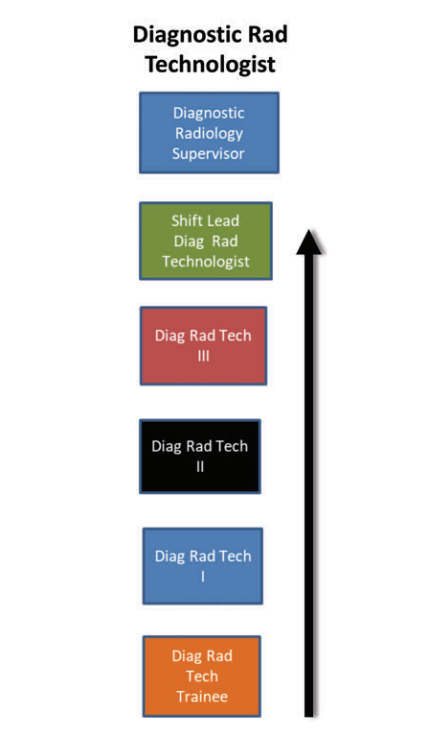
Figure 1 – A career ladder framework with clearly defined levels and progression criteria.
Providing Training and Development
A practical career ladder must be accompanied by robust training and development programs. Some organizational systems unknowingly restrict training opportunities through their budgeting processes. Even when trainee positions are built into a cost center, an open position must often be budgeted or added to the cost center to move the employee from one cost center to the other, which can openly restrict the opportunity to cross-train (Figure 2A). Creating advanced or multi-modality pathways in each cost center can eliminate this restriction and allow an organization to cross-train modalities without the need to balance or reallocate full-time employees. This will allow the department administrator the option to cross-train through either pathway (Figure 2B).
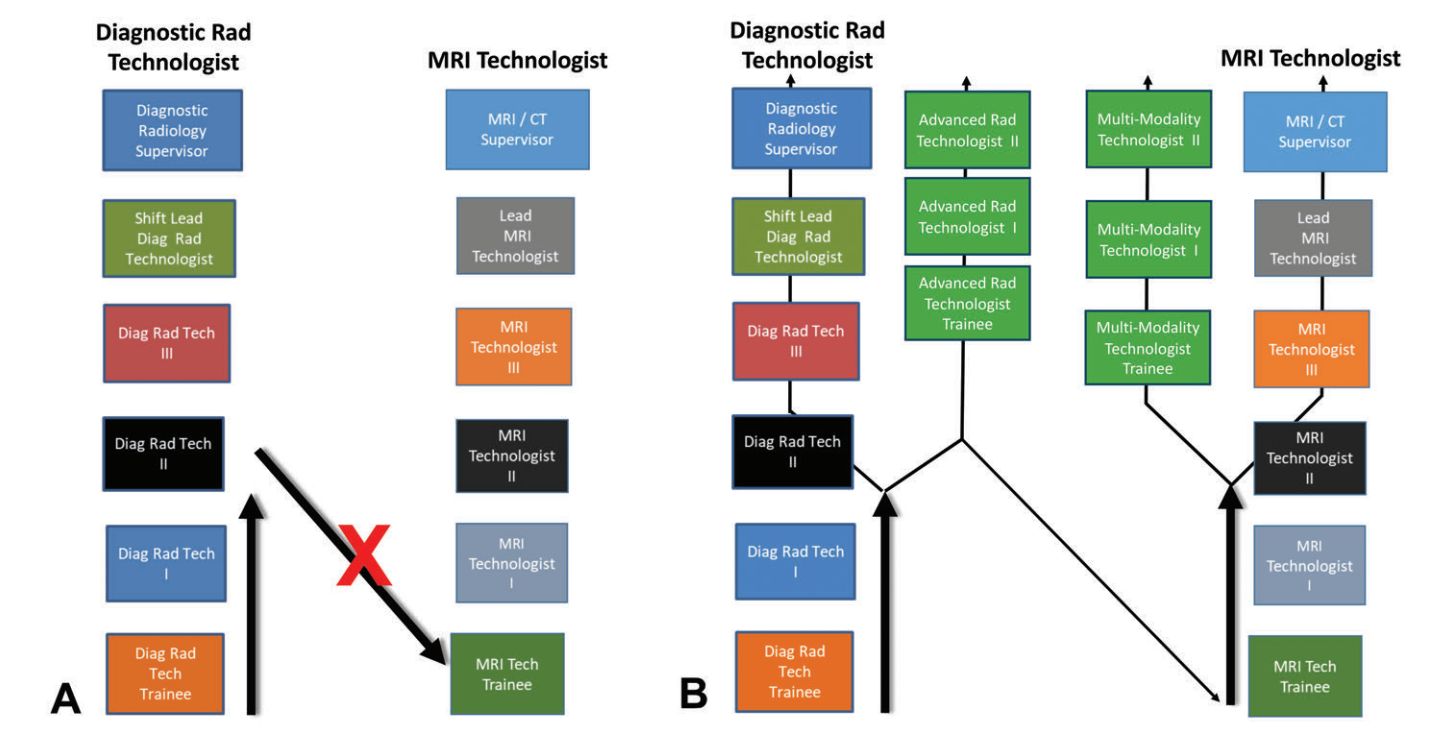
Figure 2 – A career ladder without (A) and with (B) advanced, multi-modality pathways in each cost center. Multi-modality career ladders allow an organization to cross-train modalities without the need to balance or reallocate full-time employees. A department administrator is able to cross-train through either pathway.
It should be noted that in this example, the organization can set the diagnostic radiology (DR) and MRI pathway requirements. The requirements for a technologist who remains in the DR pathway and cross-trains in MRI may be defined as 20 hours per week in each modality — 80% diagnostic and 20% MRI — or what best fits the role’s needs. The MRI trainee in the MRI pathway would be used when the technologist will perform 100% of their job function in the MRI cost center.
Offering workshops, cross-training opportunities, and certification preparation courses empowers technologists to acquire the skills and knowledge needed to advance. These programs can focus on clinical expertise, leadership development, or operational management by pathway, ensuring employees are prepared for new challenges. Organizations that invest in their workforce through education foster loyalty, job satisfaction, and improved patient care.
Collaborating with professional organizations like the ARRT, the American Society of Radiologic Technologists (ASRT), and the Association for Medical Imaging Management (AHRA) further enhances training initiatives. These organizations offer industry-recognized certifications, educational resources, and networking opportunities that complement internal development programs. Figure 3 shows an example of how the ARRT Advanced Certification is used to define an advanced radiologic technologist. By partnering with such entities, employers can provide access to the latest industry knowledge and best practices, equipping technologists with the tools to excel in their careers.
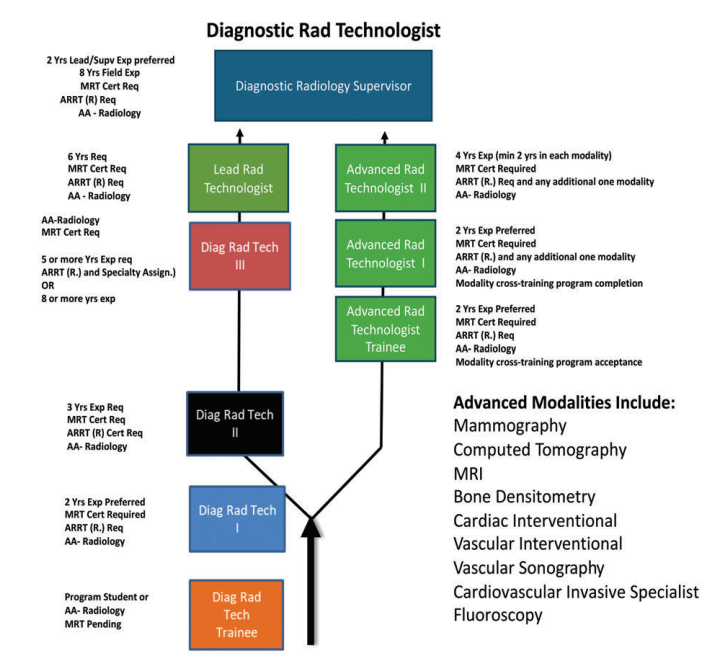
Figure 3 – An example of how the ARRT Advanced Certification is used to define an advanced radiologic technologist.
Implementing Mentorship Programs
Mentorship programs are a valuable component of any career ladder, pairing junior technologists with experienced staff for guidance and support. Mentors can provide practical advice, share experiences, and offer encouragement as mentees navigate their career paths. These relationships foster community, build confidence, and help junior technologists develop technical and soft skills. A structured mentorship program promotes knowledge transfer, ensuring institutional expertise is passed down to the next generation of professionals.
Mentorship programs also benefit mentors, offering opportunities to refine leadership skills and gain fulfillment from contributing to their colleagues’ growth. By cultivating a culture of mentorship, organizations can strengthen their workforce, improve retention, and create a supportive environment where employees are motivated to reach their full potential.
Monitoring and Revising
Once the career ladder is implemented, regular monitoring and revision are essential to ensure its effectiveness and relevance. Periodic evaluations should assess whether the framework achieves its intended outcomes, such as improved employee satisfaction, increased retention, and enhanced departmental performance. These evaluations can include metrics like promotion rates, feedback from staff, and alignment with industry trends.
Revising the career ladder based on feedback and evolving organizational needs is critical to maintaining its value. For example, as new imaging technologies emerge or regulatory standards change, the framework may need updates to incorporate new skills and certifications. A dynamic approach to monitoring and revision ensures that the career ladder remains a relevant and powerful tool for professional development and organizational growth.¹⁸
Developing Comprehensive Job Descriptions
Job descriptions are pivotal in successfully implementing a medical imaging career ladder by providing a clear framework for growth and development. They clarify roles, responsibilities, and expectations at each level, ensuring employees understand their current positions and the steps required to advance.¹⁹ Job descriptions promote transparency by detailing the qualifications and competencies needed for progression, helping staff align their professional goals with organizational requirements. Moreover, these descriptions serve as a foundational tool for performance evaluations and promotions, offering objective criteria to assess achievements and readiness for higher-level responsibilities. This clarity and structure foster a sense of purpose, accountability, and motivation, making job descriptions an essential component of a well-designed career ladder.
Steps to Build Effective Job Descriptions
- Identify principal duties and responsibilities: To create effective job descriptions for an imaging career ladder, it is essential to tailor core responsibilities for each role, considering the unique requirements at every level. For entry-level roles, descriptions should focus on foundational duties, such as operating imaging equipment, ensuring patient safety, and adhering to standard protocols.¹⁹ For specialized roles, job descriptions should highlight modality-specific responsibilities, such as managing contrast administration for CT or optimizing image acquisition techniques for MRI. Supervisory roles should emphasize oversight duties, including team management, workflow coordination, and compliance monitoring. By customizing descriptions for each level, organizations ensure that employees clearly understand their day-to-day tasks and expectations, setting the stage for accountability and professional growth (example in Figure 4).
- Align with career ladder levels: Job descriptions should map roles to specific levels within the career ladder framework, such as Technologist I, II, and III. This section was added after the principal duties/responsibilities section for advanced and multi-modality roles. It should be specific to earned modality, as shown in Figure 4. This alignment gives employees a structured understanding of where they currently stand and what is required to progress to the next level. Each job description should explicitly state the skills, certifications, and performance benchmarks needed for advancement.¹⁹ For example, a Technologist II role might require experience in multiple modalities or demonstrated leadership abilities. In contrast, a Technologist III role could emphasize expertise in advanced imaging techniques or team training responsibilities. Highlighting these progression opportunities within the job description motivates employees to pursue growth and fosters a culture of continuous development.
- Define minimum qualifications: Defining minimum qualifications is crucial to establishing transparent and equitable criteria for each role within the career ladder. These qualifications should specify the certifications, licenses, and educational levels necessary to perform the job effectively. For instance, a general radiography technologist may need ARRT certification in radiography, while an MRI technologist would require additional MRI-specific certification. Beyond technical qualifications, it is equally important to include soft skills such as effective communication, teamwork, and problem-solving, vital for patient care and collaboration in a fast-paced healthcare environment (as shown in Figure 5). Clearly outlining these qualifications ensures transparency in hiring and promotion processes while setting a standard for competency across the organization.
- Incorporate leadership and specialization tracks: Effective job descriptions should address responsibilities for advanced roles within leadership or specialization tracks. For example, descriptions for roles such as Lead Technologist or Radiologist Assistant should detail supervisory responsibilities, mentorship expectations, or advanced clinical duties. Similarly, administrative or leadership role descriptions include strategic planning, budgeting, and policy development tasks. Job descriptions provide clear pathways to these advanced roles within the career ladder. They help technologists envision long-term career prospects, whether they aspire to become technical experts or move into administrative leadership. This clarity supports employee retention and ensures alignment between individual ambitions and organizational needs.
- Collaborate with stakeholders: Building effective job descriptions requires collaboration with key stakeholders, including HR professionals, department heads, and current technologists. Input from these groups ensures that job descriptions are practical, comprehensive, and aligned with the realities of daily work. For instance, technologists can provide insights into nuances of modality-specific principle duties and responsibilities, while HR can ensure compliance with legal and organizational standards.³ ²⁰ Additionally, aligning job descriptions with organizational goals and accreditation standards, such as those from The Joint Commission or ARRT, ensures that they support employee development and regulatory compliance.²¹ Stakeholder collaboration fosters buy-in from all levels of the organization, creating job descriptions that are accurate, widely supported, and effectively implemented.
Job descriptions are a foundational tool in career development, particularly in structured frameworks like a medical imaging career ladder. By clearly outlining the roles and responsibilities at each level, job descriptions help technologists understand the skills they need to acquire to advance their careers.¹⁹ For example, an entry-level technologist may learn from their job description that foundational skills in patient positioning and safety protocols are essential. At the same time, advanced roles may require expertise in specialized modalities like MRI or CT. This clarity empowers employees to identify the specific qualifications, certifications, or experiences they need to progress. When technologists understand the requirements for growth, they can set informed career goals and proactively work toward achieving them, aligning their ambitions with organizational expectations.
In addition to guiding individual career aspirations, job descriptions serve as a benchmark for training and professional development programs. Organizations can use the skills and qualifications outlined in job descriptions to design targeted workshops, certification preparation courses, or continuing education programs that address workforce needs.¹⁹ For instance, in the description for a senior technologist role highlights the need for proficiency in advanced imaging technologies allows the organization to offer specialized training in those areas to bridge skill gaps and prepare staff for promotion. These benchmarks also allow employees to evaluate their current capabilities against job requirements, making it easier to identify areas for improvement and seek out relevant learning opportunities. By aligning training programs with job descriptions, organizations ensure that employees are equipped to meet the demands of higher-level roles, fostering a culture of continuous learning and professional growth.¹⁴ ¹⁹
Ultimately, job descriptions provide a roadmap for individual advancement and strengthen the organization’s talent pipeline. When technologists see a clear career progression pathway, they are more likely to remain engaged and motivated. Concurrently, organizations benefit from a more skilled and prepared workforce, reducing the need for external recruitment and enhancing overall operational effectiveness. Through their role in clarifying expectations and shaping professional development, job descriptions are vital to career advancement strategies in medical imaging.
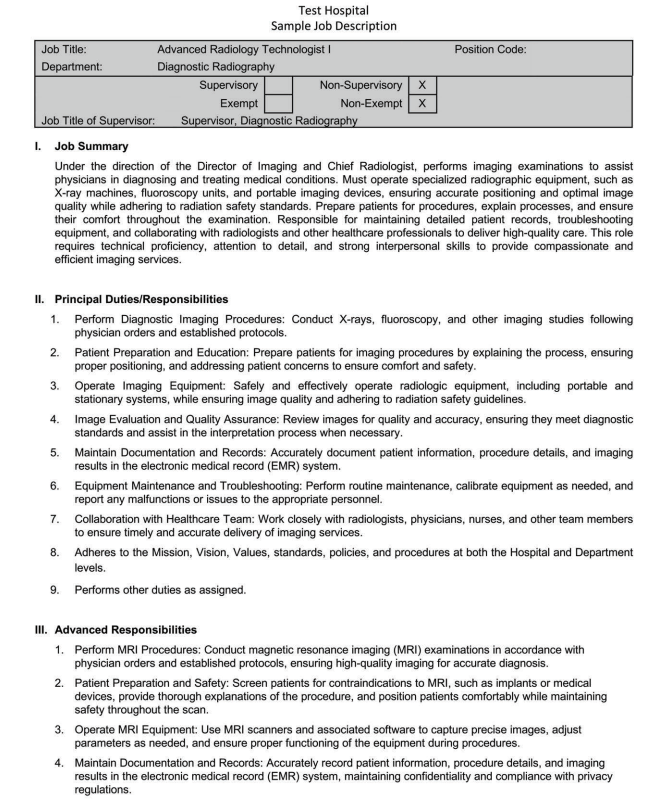
Figure 4 – To maintain an effective career ladder, it is necessary to create detailed job descriptions with core responsibilities tailored to each role. This job description begins with a job summary, then principal duties and responsibilities, followed by advanced responsibilities.
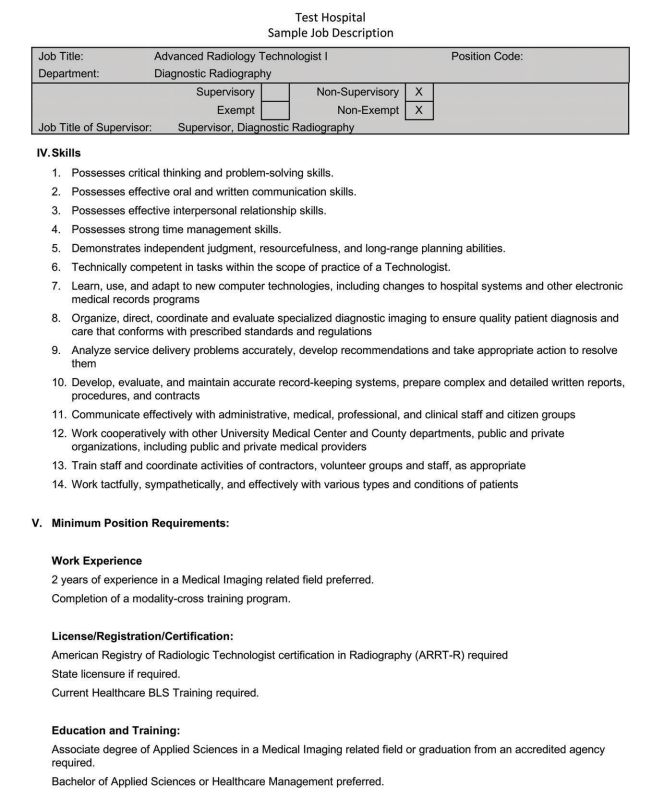
Figure 5 – An effective job description must also include a detailed list of skills and minimum qualifications.
Challenges and Solutions
Funding Constraints
Funding constraints are one of the most significant challenges in implementing a medical imaging career ladder. Developing and maintaining a robust career ladder requires resources for training programs, certification reimbursements, mentorship initiatives, and potential salary adjustments for advanced roles. Organizations facing tight budgets often struggle to allocate sufficient funds to these initiatives. However, strategies such as securing grants, timely budget planning, or reallocating resources can provide viable solutions. Healthcare institutions can explore grants offered by professional organizations, government agencies, or philanthropic foundations that support workforce development in medical imaging. Reallocating existing resources by prioritizing career development initiatives over less critical expenditures can also ensure that funds are directed toward impactful programs. Creative solutions like offering in-house training or leveraging partnerships with educational institutions can also reduce costs while maintaining program quality where available.
An important aspect of career ladder implementation is to align the pathways with the organization’s salary grading and ensure it reflects current market trends to ensure competitiveness and equity.²² A salary grading structure will make long-term budgeting easier throughout the career progression. Figure 6 depicts a structured progression of roles within the medical imaging profession, starting with entry-level positions and advancing to senior leadership roles. The ladder may be organized into levels, with each step representing increased responsibilities, competencies, expertise, and defined salary grades. At the foundation are trainee roles, which are either student technologist or modality trainee roles depending on the pathway. The ladder progresses to specialized technologist roles, including CT, MRI, and multi-modality technologist positions, highlighting pathways for technical growth and advanced certifications. Leadership opportunities begin at the lead technologist level, expanding into supervisory and management roles and culminating in executive-level positions such as administrative director.
This structure emphasizes multiple pathways for career growth, accommodating diverse specialties and interests within the imaging field while ensuring alignment with organizational structures and goals. This structure also allows the organization to attract and retain top talent while rewarding increased competencies, certifications, and responsibilities. Aligning the ladder with market demands also ensures that compensation remains fair and consistent with industry standards, motivating employees to pursue advancement while meeting organizational goals for high-quality patient care and operational excellence.²³
The salary grade structure also adjusts each pathway to the organization’s market. If the market region is in an area with an excess or flood of one modality, the pathway can be adjusted to align the salary grades with the market expectations. Figure 7 shows an example where the salary grades for the ultrasound pathway are placed lower on the scale due to an excess number of sonographers in the market. Aligning all the imaging pathways allows the administrator to plan and adjust salary expectations to meet the individual organization’s needs.

Figure 6 – An example of an organization’s salary grading structure, showing a progression of roles within the medical imaging profession, starting with entry-level positions and advancing to senior leadership roles.
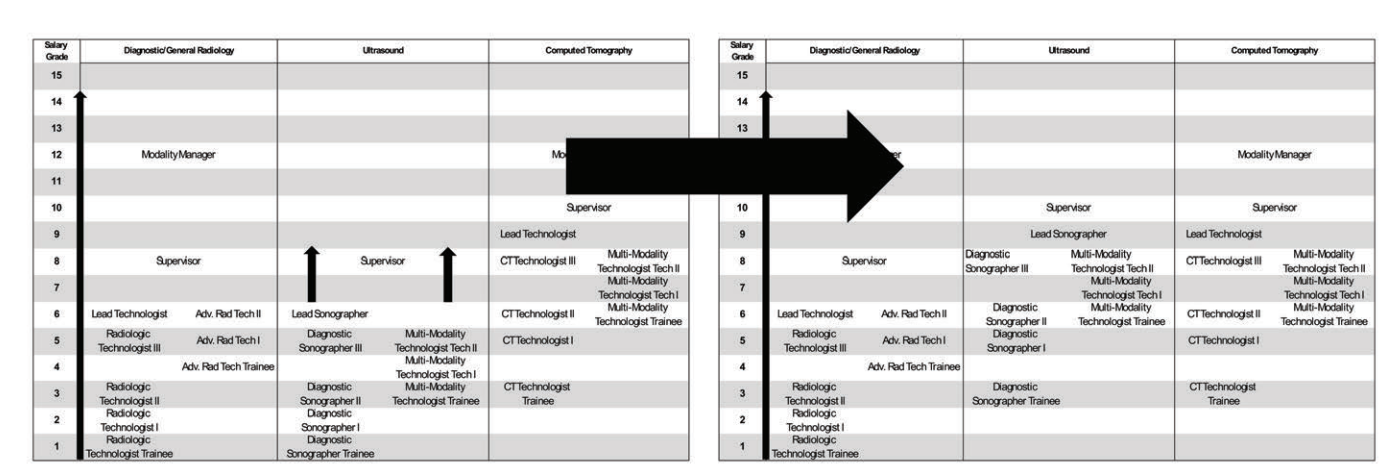
Figure 7 – Salary grade structure can be adjusted to an organization’s market. On the left, the salary grades for the ultrasound pathway are placed lower on the scale due to an excess number of sonographers in the market. The scale can be modified as the market changes, as shown on the right.
Resistance to Change
Resistance to change is another common obstacle when introducing a career ladder in medical imaging. Employees and leaders may be hesitant to embrace new structures or processes due to uncertainty, fear of increased workload, the amount of work to implement the changes, or skepticism about the benefits. Overcoming these barriers requires effective communication and involvement at all levels of the organization. Transparent communication about the career ladder’s purpose, goals, and potential benefits is essential to build trust and support. Engaging staff through focus groups, surveys, and open forums can provide a platform for addressing concerns and incorporating valuable input.²⁴ Additionally, involving key stakeholders such as HR, department leaders, and senior technologists in the design and implementation process fosters a sense of ownership and encourages buy-in.
Measuring Success
As mentioned, a well-structured medical imaging career ladder can significantly enhance workforce stability, satisfaction, and competence. To measure the overall success of a medical imaging career ladder, organizations can create a balanced scorecard combining key performance indicators (KPIs), patient care outcomes, and organizational growth metrics.²⁵ Regularly reviewing this data provides insights into the program’s effectiveness and identifies areas for improvement. Celebrating successes, such as achieving certification milestones or expanding service offerings, reinforces the value of the career ladder to both staff and leadership.
Retention in advanced roles is a key indicator of how effectively a career ladder supports employee satisfaction and aligns with career aspirations. High retention rates in leadership or specialized positions suggest employees find their roles fulfilling and feel adequately prepared due to robust training and development programs.²⁶ These metrics highlight the success of the career ladder in fostering long-term career satisfaction and readiness. Conversely, declines in retention may signal the need for enhanced professional development or leadership support.
Other critical metrics include skill gap reduction and onboarding completion rates. Periodic skills assessments highlight areas where employees need development and measure progress as training initiatives take effect.¹⁴ ²⁶ A decrease in skill gaps demonstrates the career ladder’s success in equipping staff to meet evolving demands. Meanwhile, onboarding and orientation completion rates reflect how effectively new hires are integrated into the organization and introduced to career development opportunities. High completion rates signal a commitment to employee success and enhance the career ladder’s appeal during recruitment. Together, these metrics provide actionable data to refine and enhance the career ladder, ensuring alignment with strategic goals and fostering a culture of growth and retention.
Equally important are managerial performance metrics, which assess the success of employees promoted through the career ladder into leadership roles.27 Metrics such as team productivity, employee satisfaction, and retention within teams led by promoted leaders provide valuable insights into leadership training and preparation effectiveness. High performance and positive team dynamics signal that leaders effectively apply their training, while challenges may reveal areas requiring additional support. By consistently tracking these metrics, organizations can ensure that their career ladder fosters leadership advancement and sustained excellence in leadership performance, forming a solid foundation for organizational success.
Conclusion
A well-designed career ladder for medical imaging technologists is more than just a framework for advancement; it is a strategic investment in employee development and organizational success. Career ladders empower technologists to achieve their professional aspirations while addressing critical workforce challenges such as retention, engagement, and skill enhancement by offering structured pathways that align with salary grading, market trends, and institutional goals. Incorporating clear progression criteria, specialized training opportunities, and leadership development programs ensures that the ladder remains dynamic and relevant in an ever-evolving healthcare landscape. Implementing such a system strengthens the workforce and enhances patient care and operational excellence, solidifying the organization’s reputation as an employer of choice and a leader in clinical quality.
References
- Maslova TA and Romanov VA. Pedagogical Conditions for the Formation of Professional and Personal Identity of Teachers of Additional Education. SHS Web of Conferences. https://doi.org/10.1051/shsconf/202111300064.
- Zdraves V. Crafting the Right Strategic Framework for Your Company. KnowInsiders. https://knowinsiders.com/crafting-the-right-strategic-framework-for-your-company-38166.html. Published September 6, 2023. Accessed January 20, 2025.
- Developing Employee Career Paths and Ladders. Society for Human Resource Management (SHRM). https://www.shrm.org/topics-tools/tools/toolkits/developing-employee-career-paths-ladders. Accessed January 20, 2025.
- Snively E. How to Create a Clinical Ladder to Improve Nurse Retention and Performance. Relias. https://www.relias.com/blog/how-to-create-a-clinical-ladder-to-improve-nurse-retention-and-performance. Published April 17, 2024. Accessed January 20, 2025.
- Career Development Programs for Medical Imaging Professionals. Mayo Clinic. https://www.mayoclinichealthsystem.org/locations/la-crosse/careers. Accessed January 20, 2025.
- Careers Over Jobs: Fostering Professional Growth via Internal Mobility. Cleveland Clinic. https://consultqd.clevelandclinic.org/careers-over-jobs-fostering-professional-growth-via-internal-mobility. Published February 15, 2024. Accessed January 20, 2025.
- Bothra R. Employer Brand Building for Effective Talent Management. Indian Scientific Journal of Research in Engineering and Management. 2024;8(5). https://doi.org/10.55041/ijsrem34549.
- About Us. Accrediting Bureau of Health Education Schools (ABHES). https://www.abhes.org. Accessed January 20, 2025.
- Certification and Registration Requirements. American Registry of Radiologic Technologists (ARRT). https://www.arrt.org/pages/earn-arrt-credentials/requirements. Accessed January 20, 2025.
- What is a CT Tech in Healthcare. CareRev. https://www.carerev.com/blog/what-is-a-ct-tech. Published March 19, 2024. Accessed January 20, 2025.
- Tools and Resources for Health Education Professionals. American Profession Guide. https://americanprofessionguide.com/tools-and-resources-for-health-education-professionals. Published July 27, 2024. Accessed January 20, 2025.
- About CRA. Radiology Administration Certification Commission (RACC). https://www.crainfo.org/home. Accessed January 20, 2025.
- How to Advance Your Career in Radiologic Technology. LSU Online. https://www.online.lsu.edu/newsroom/articles/how-to-advance-your-career-in-radiologic-technology. Accessed January 20, 2025.
- Verlinden N. Skills Gap Analysis: All You Need to Know. Academy To Innovate HR. https://www.aihr.com/blog/skills-gap-analysis. Accessed January 20, 2025.
- Career Development Surveys: Using Surveys to Support Employee Development. Edgecumbe Consulting Group Ltd. https://www.edgecumbe.co.uk/career-development-surveys-using-surveys-to-support-employee-development. Accessed January 20, 2025.
- Professional Development and Continuing Education for Imaging Professionals. American Society of Radiologic Technologists (ASRT). https://www.asrt.org/main/continuing-education. Accessed January 20, 2025.
- About AHRA. American Healthcare Radiology Administrators (AHRA). https://www.ahra.org/about/about-ahra. Accessed January 20, 2025.
- Benefits of Outsourcing Provider Credentialing to Billing Company. BillingFreedom. https://billingfreedom.com/outsource-provider-credentialing-to-billing-company. Published April 17, 2024. Accessed January 20, 2025.
- Ramhit K. The Impact of Job Description and Career Prospect on Job Satisfaction: A Quantitative Study in Mauritius. SA Journal of Human Resource Management. 2019;17(0):a1092. https://doi.org/10.4102/sajhrm.v17i0.1092.
- Nine in 10 Malaysian Employees Surveyed Want Upskilling Opportunities from their Employers. Human Resources Online. https://humanresourcesonline.net/nine-in-10-malaysian-employees-surveyed-want-upskilling-opportunities-from-their-employers. Published March 7, 2022. Accessed January 20, 2025.
- Standards for Diagnostic Imaging Services. The Joint Commission. https://www.jointcommission.org/standards. Accessed January 20, 2025.
- Radiologic and MRI Technologists. Occupational Outlook Handbook: Radiologic and MRI Technologists. U.S. Department of Labor. https://www.bls.gov/ooh/healthcare/radiologic-technologists.htm. Published August 29, 2024. Accessed January 20, 2025.
- Cave D. 3 Steps to Aligning Compensation Planning with Organisational Goals. Cezanne HR Limited. https://cezannehr.com/hr-blog/2024/03/3-steps-to-aligning-compensation-planning-with-organisational-goals. Published March 14, 2024. Accessed January 20, 2025.